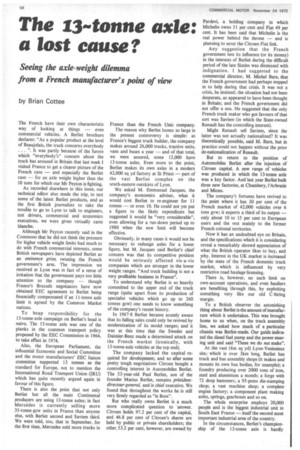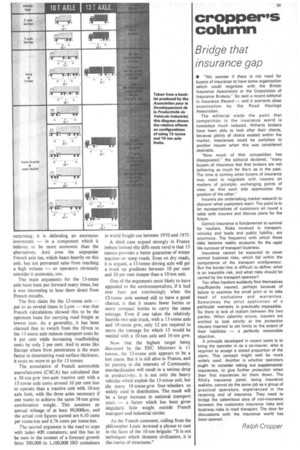The 13-tonne axle: a lost cause?
Page 54

Page 55

If you've noticed an error in this article please click here to report it so we can fix it.
Seeing the axle-weight dilemma from a French manufacturer's point of view
by Brian Coffee
The French have their own characteristic way of looking at things — even commercial vehicles. A Berliet brochure declares: "As a popular product at the level of Beaujolais, the truck concerns everybody . . . It was partly because of the furore which "everybody's" concern about the truck has aroused in Britain that last week I visited France to get a clearer picture of the French case — and especially the Berliet case — for an axle weight higher than the 10 tons for which our Mr Peyton is fighting.
As recorded elsewhere in this issue, our technical editor also made the trip, to test some of the latest Berliet products, and as the first British journalists to take the trouble to go to Lyon to talk to engineers, test drivers, commercial and economics executives, we were given virtually carte blanche.
Although Mr Peyton recently said in the Commons that he did not think the pressure for higher vehicle weight limits had much to do with French commercial interests, some British newspapers have depicted Berliet as an eminence grise, twisting the French government's arm. The impression we received at Lyon was in fact of a sense of irritation that the government pays too little attention to the company — though France's Brussels negotiators have now obtained EEC agreement to Berliet being financially compensated if an 11-tonne axle limit is agreed by the Common Market nations.
To heap responsibility for the 13-tonne-axle campaign on Berliet's head is naive. The 13-tonne axle was one of the planks in the common transport policy proposed by the EEC Commission in 1964, to take effect in 1974.
Also, the European Parliament, the influential Economic and Social Committee and the motor manufacturers' EEC liaison committee supported 13 tonnes as the standard for Europe, not to mention the International Road Transport Union (IRU) which has quite recently argued again in favour of this figure.
There is also the point that not only Berliet but all the main Continental producers are using 13-tonne axles; in fact Mercedes is currently selling more 35-tonne-gcw units in France than anyone else, with Berliet second and Saviem third. We were told, too, that in September, for the first time, Mercedes sold more trucks in France than the French Unic company.
The reason why Berliet looms so large in the present controversy is simple: as France's biggest truck builder, the company makes around 26,000 trucks, tractive units, vans and buses a year — and of that total, we were assured, some 12,000 have 13-tonne axles. Even more to the point, Berliet makes its own axles in a modern 42,000 sq yd factory at St Priest — part of the vast Berliet complex on the south-eastern outskirts of Lyon.
We asked M. Emmanuel Jacques, the company's economics adviser, what it would cost Berliet to re-engineer for 11 tonnes — or even 10. He could not yet put a figure to the likely expenditure but suggested it would be "very considerable", even allowing for a run-down period up to 1980 when the new limit will become effective.
Obviously, in many cases it would not be necessary to redesign axles for a lower figure, but M. Jacques said Berliet's chief concern was that its competitive position would be seriously affected vis-a-vis companies which are stronger in the lower weight ranges. "And truck building is not a very profitable business in France".
To understand why Berliet is so heavily committed to the upper end of the truck range (quite apart from its production of specialist vehicles which go up to 260 tonnes gcw) one needs to know something of the company's recent history.
In 1967-8 Berliet became acutely aware that its falling sales could only be revived by modernization of its model ranges; and it was at this time that the Swedes and Daimler-Benz made a determined attack on the French market (ironically, with 13-tonne-wde vehicles at the top end).
The company lacked the capital required for development; and so after some pretty tough negotiations Citroen bought a controlling interest in Automobiles Berliet. The 53-year-old Paul Berliet, son of the founder Marius Berliet, remains presidentdirecteur-general, and is chief executive. We found that throughout the works he is still very firmly regarded as "le Boss".
But who really owns Berliet is a much more complicated question to 'answer. Citroen holds 97.2 per cent of the capital, and 46.8 per cent of Citroen's shares are held by public or private shareholders; the other. 53.2 per cent, however, are owned by Pardevi, a holding company in which Michelin owns 51 per cent and Fiat 49 per cent. It has been said that Michelin is the real power behind the throne — and is planning to sever the Citroen-Fiat link.
Any suggestion that the French government lent its influence (or its money) in the interests of Berliet during the difficult period of the late Sixties was dismissed with indignation. I had suggested to the commercial director, M. Michel Bure, that the French government had perhaps stepped in to help during that crisis. It was not a crisis, he insisted; the situation had not been desperate, as appeared to have been thought in Britain; and the French government did not offer a sou. He suggested that the only French truck maker who got favours of that sort was Saviem (in which the State-owned Renault has the controlling interest).
Might Renault sell Saviem, since the latter was not actually nationalized? It was theoretically possible, said M. Bure, but as practice could not happen without the prior de-nationalization of Renault.
But to return to the position of Automobiles Berliet after the injection of Citroen capital. A new range of vehicles was produced in which the 13-tonne axle was a key factor. And last year Berliet built three new factories, at Chambery, l'Arbresle and Mions.
The company's fortunes have revived to the point where it has 30 per cent of the French market of 42,000 vehicles over 6 tons gvw; it exports a third of its output — only about 10 to 15 per cent to European users and the rest mainly to the former French colonial territories.
Now it has an undoubted eye on Britain, and the specifications which it is considering reveal a remarkably shrewd appreciation of what the British operator likes to buy, and yhy. Interest in the UK market is increased by the state of the French domestic truck market, which is influenced by very restrictive road haulage licensing.
There is, however, no such limit on own-account operations, and even hauliers are benefiting through this, by exploiting something very like our old C-hiring margin.
To a British observer the astonishing thing about Ballet is the amount of manufacture which it undertakes. This was brought home to us when, on the truck assembly line, we asked how much of a particular chassis was Berliet-made. Our guide indicated the diesel fuel pump and the power steering unit and said "These we do not make".
At the vast (4m sq yd) Lyon-Venissieux site,' which is over 3km long, Berliet has truck and bus assembly shops (it makes and mounts its own bus bodies, for example); a foundry producing over 2000 tons of iron, steel and aluminium a month; a forge with 72 drop hammers; a 95-press die-stamping shop; a vast machine shop; a complete engine factory; a component plant making axles, springs, gearboxes and so on.
The whole enterprise employs 20,000 people and is the biggest industrial unit in South East France — itself the second most important industrial area of the country.
In the circumstances, Berliet's championship of the 13-tonne axle is hardly surprising; it is defending an enormous investment — in a component which it believes to be more economic than the alternatives. And even the unpopular French axle tax, which bears heavily on this unit, has not prevented sales from reaching a high volume — so operators obviously consider it economic, too.
The main arguments for the 13-tonne axle have been put forward many times, but it was interesting to hear them direct from French mouths.
The first claim for the 13-tonne axle put to us several times in Lyon — was that French calculations showed this to be the optimum basis for carrying road freight at lowest cost. As a generality, it has been claimed that to switch from the 10-ton to the 13-tonne axle reduces transport costs by 8 per cent while increasing roadbuilding costs by only 2 per cent. And in areas like Europe where frost penetration is the main factor in determining road surface thickness, it costs no more to go for 13 tonnes The association of French automobile manufacturers (CSCA) has calculated that a 38-ton gcw two-axle tractive unit with a 13-tonne axle costs around 10 per cent less to operate than a tractive unit with 10-ton axle limit, with the three axles necessary if one wants to achieve the same 38-ton gross combination weight. This assumes an annual mileage of at least 90,000km, and the actual cost figures quoted are 6.10 cents per tonne-km and 6.76 cents per tonne-km.
The second argument is the need to cope with laden 40ft containers; and this has to be seen in the context of a forecast growth from 300,000 to 1,100,000 ISO containers in world freight use between 1970 and 1975.
A third case argued strongly in France (where limited-slip diffs seem rare) is that 13 tonnes provides a better guarantee of winter traction on steep roads. Even on dry roads, it is argued, a 13-tonne driving axle will get a truck up gradients between 10 per cent and 20 per cent steeper than a 10-ton unit.
One of the arguments most likely to have appealed to the environmentalists, if it had ever been put convincingly when the 13-tonne axle seemed still to have a good chance, is that it means fewer lorries or more compact lorries to carry the same tonnage. Even if one takes the relatively humble two-axle truck, with a 13-tonne axle and 19-tonne gvw, only 12 are required to move the tonnage for which 15 would be needed with a 10-ton axle and 16-ton gvw.
Now that the highest target being discussed by the EEC Ministers is 11 tonnes, the 13-tonne axle appears to be a lost cause. But it is still alive in France, and its passing in the interests of Community standardization will result in a serious drop in productivity; it is not only the heavy vehicles which exploit the 13-tonne unit, but the many 19-tonne-gvw four-wheelers so widely used in distribution. The result will be a large increase in national transport costs — a factor which has been given singularly little weight outside French transport and industrial circles.
As the French comment, culling from the philosopher Louis Armand a phrase to cast in the faces of the 10-ton brigade: "It is not techniques which threaten civilization, it is the. inertia of structures,"












































































































